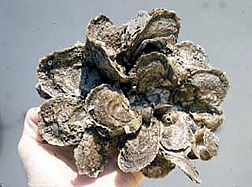This page has been archived and is being provided for reference purposes only. The page is no longer being updated, and therefore, links on the page may be invalid.
|
|
Canada Adopts Method to Extract Noroviruses from Oysters
By Jim CoreMarch 24, 2006
Several agencies responsible for public health oversight in Canada recently adopted a technique based on research by Agricultural Research Service (ARS) scientists to extract and test noroviruses in oysters.
Noroviruses, which cause approximately 23 million illnesses each year, are the leading cause of nonbacterial acute gastroenteritis outbreaks. They are associated with outbreaks in schools and nursing homes, on cruise ships, and with the consumption of contaminated water and food.
The extraction method is based on a procedure published in 2001 by microbiologist David H. Kingsley and lead scientist Gary P. Richards at the ARS Microbial Safety of Aquaculture Products Center of Excellence at Delaware State University in Dover.
Health Canada recently published the procedure as a laboratory method in its “Compendium of Analytical Methods,” which provides a ready reference on techniques used by Health Canada, Agriculture and Agri-Food Canada, and the Canadian Food Inspection Agency.
These agencies evaluated the method for effectiveness, as did the U.S. Food and Drug Administration, the British Columbia Centre for Disease Control, state and provincial universities, and other agencies. The publication is available online at:
http://www.hc-sc.gc.ca/fn-an/res-rech/analy-meth/microbio/volume5/index_e.html
The method effectively separates and purifies norovirus genetic materials from within oyster tissues.
Oysters, clams and mussels have caused numerous outbreaks of norovirus illness. Symptoms of the illness include potentially severe diarrhea, vomiting or both that develop usually within a day after consuming contaminated food or drink. Symptoms typically last for about 48 hours.
In 2002, the ARS researchers published an article on the successful use of the method to detect both hepatitis A virus and norovirus in Asian clams implicated in an outbreak of norovirus illness in New York State. Canadian scientists first contacted Richards in 2004 about a suspected outbreak of oyster-associated norovirus illness in British Columbia, which led to an evaluation of the ARS method.
ARS is the U.S. Department of Agriculture’s chief scientific research agency.

